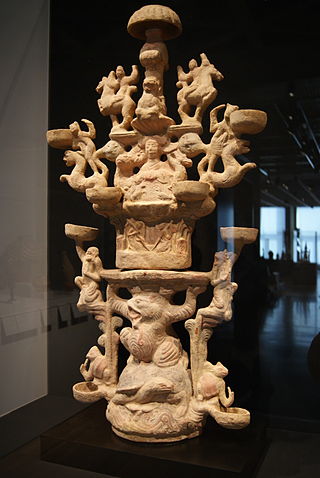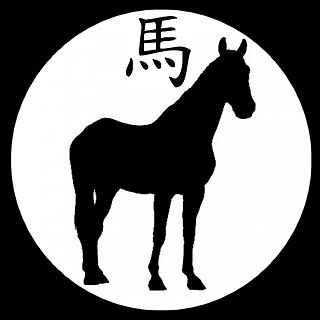Mythological geography of China
"Chinese mythology" refers to mythology associated with the geographic area now known as "China", and in traditional Chinese mythology often known as the "Middle Kingdom". Chinese mythology includes many varied myths from regional and cultural traditions. Chinese mythology is far from monolithic, not being an integrated system, even among just Han people. Chinese mythology is encountered in the traditions of various classes of people, geographic regions, historical periods including the present, and from various ethnic groups.
China is the home of many mythological traditions, including that of Han Chinese and their Huaxia predecessors, as well as Tibetan mythology, Turkic mythology, Korean mythology, and many others. The study of Chinese mythology tends to focus upon material in Chinese language. Much of the mythology involves exciting stories full of fantastic people and beings, the use of magical powers, often taking place in an exotic mythological place or time. Along with Chinese folklore, Chinese mythology forms an important part of Chinese folk religion (Yang 2005, 4, and elsewhere). In these cases, Chinese mythological geography forms and informs these ideational processes.

Chinese mythology is mythology that has been passed down in oral form or recorded in literature throughout the area now known as Greater China. Chinese mythology encompasses a diverse array of myths derived from regional and cultural traditions. Populated with engaging narratives featuring extraordinary individuals and beings endowed with magical powers, these stories often unfold in fantastical mythological realms or historical epochs. Similar to numerous other mythologies, Chinese mythology has historically been regarded, at least partially, as a factual record of the past.
Gonggong is a Chinese water god who is depicted in Chinese mythology and folktales as having a copper human head with an iron forehead, red hair, and the body of a serpent, or sometimes the head and torso are human, with the tail of a serpent. He is destructive and is blamed for various cosmic catastrophes. In all accounts, Gonggong ends up being killed or sent into exile, usually after losing a struggle with another major deity such as the fire god Zhurong.
Mount Buzhou was an ancient Chinese mythological mountain which, according to old texts, lay to the northwest of the Kunlun Mountains, in a location today referred to as the Pamir Mountains. It is the mountain said to have supported the heavens, against which the Chinese water god Gonggong smashed his head in a fit of anger, requiring the goddess Nüwa to repair the sky. Nevertheless, once the spacer between the Earth and Sky was damaged, the land of China was permanently tilted to the southeast, causing all the rivers to flow in that same direction.

The Kunlun or Kunlun Shan is a mountain or mountain range in Chinese mythology, an important symbol representing the axis mundi and divinity.
Four Mountains or Four Peaks variously interpreted from Chinese mythology or the most ancient level of Chinese history as being a person or four persons or four gods, depending upon the specific source. The ambiguous Four Mountains feature prominently in the myth of the Great Flood, and the related myths of Emperor Yao, Gun, Shun, and Yu the Great.
Jade Mountain is a mythological mountain in Chinese mythology and the residence of The Queen Mother of the West.
Feather Mountain is one of many important mythological mountains in Chinese mythology, particularly associated with the Great Flood. According to the mythological studies of Lihui Yang, Gun was executed on the "outskirts" of Feather Mountain by Zhu Rong, either for stealing the xirang or for failing to control the flood waters. According to K. C. Wu, Emperor Shun exiled Gun to Feather Mountain for lèse-majesté, but that Gun was not executed; and, rather, that such accounts result from misunderstanding the meanings associated with the ancient Chinese character jí (殛), which appears in certain source works.
The Qingniao were blue or green birds which appear in Chinese mythology, popular stories, poetry, and religion. Qingniao is especially regarded as the messengers or as otherwise serving the Queen Mother of the West Xi Wangmu. In some sources, three-legged Qingniao carry her messages; in other sources, a single one-legged Qingniao fetched her food. In some versions, three, sometimes three-legged, green birds brought her food: these seem to have some similarity with the Three-footed birds believed to reside in the sun. The Qingniao are an important motif and frequently depicted in myths regarding Xi Wangmu and her Western Paradise, which is generally located on the mythical Kunlun Mountain.

Horses are an important motif in Chinese mythology. There are many myths about horses or horse-like beings, including the pony. Chinese mythology refers to those myths found in the historical geographic area of China. This includes myths in Chinese and other languages, as transmitted by Han Chinese as well as other ethnic groups. There are various motifs of horses in Chinese mythology. In some cases the focus is on a horse or horses as the protagonist of the action, in other cases they appear in a supporting role, sometimes as the locomotive power propelling a chariot and its occupant(s). According to a cyclical Chinese calendar system, the time period of 31 January 2014 - 18 February 2015 falls under the category of the (yang) Wood Horse.

Oxen, cows, beef cattle, buffalo and so on are an important motif in Chinese mythology. There are many myths about the oxen or ox-like beings, including both celestial and earthly varieties. The myths range from ones which include oxen or composite beings with ox characteristics as major actors to ones which focus on human or divine actors, in which the role of the oxen are more subsidiary. In some cases, Chinese myths focus on oxen-related subjects, such as plowing and agriculture or ox-powered carriage. Another important role for beef cattle is in the religious capacity of sacrificial offerings.

The Yellow River Map, Scheme, or Diagram, also known by its Chinese name as the Hetu, is an ancient Chinese diagram that appears in myths concerning the invention of writing by Cangjie and other culture heroes. It is usually paired with the Luoshu Square—named in reference to the Yellow River's Luo tributary—and used with the Luoshu in various contexts involving Chinese geomancy, numerology, philosophy, and early natural science.
The Eight Pillars also known as Eight Pillars of the Sky are a concept from Chinese mythology. Located in the eight cardinal directions, they are a group of eight mountains or pillars which have been thought to hold up the sky. They are symbolically important as types of axis mundi and cosmology. Their functions in mythology ranged from pillars which functioned to hold apart the Earth and the Sky, as ladders allowing travel between the two, and as the location of various paradises or wonderland with associated magical people, plants, and animals. The Eight Pillars are a central aspect to Chinese mythology, and also have been used extensively in poetic allusion. Some variations exist, such as only having four pillars.

The Weak River also known as the Weak Water or Ruoshui is an important feature in the mythical geography of Chinese literature, including novels and poetry over a course of over two millennia from the Warring States to early Han dynasty era poetry of the Chuci onward. The Weak River is one of the mythological rivers flowing near Kunlun, home of a Western Paradise. The Weak River flowed with "water" so lacking in specific gravity that even a feather would not float, thus being a protective barrier against the unworthy, who otherwise would profane the paradise on Kunlun, and perhaps even climb up to Heaven and disturb the deities and other inhabitants residing there. In the novel Journey to the West, the Weak Water River forms one of the obstacles the fictional version of the monk Xuanzang, the magic monkey Sun Wukong, and companions must cross over on their mission to fetch the Buddhist scriptures from India and return them to Tang China.
The Red River or Red Water is an important feature in the mythological geography of Chinese literature, including novels and poetry over a course of over two millennia from the Warring States to early Han dynasty era poetry of the Chuci onward. The Red River is one of the mythological rivers said to flow from Kunlun, a mythological land, with mountainous features. Translations into English include "Scarlet River".

The Moving Sands, also known as the Flowing Sands, is an important feature in the mythological geography of Chinese literature, including novels and poetry over a course of over two millennia from the Warring States to early Han dynasty era poetry of the Chuci onward to the present. In his poem "Li Sao", author Qu Yuan describes an aerial crossing of the Moving Sands on a shamanic spiritual Journey to Kunlun. "Moving Sands forms one of the obstacles the fictional version of the monk Xuanzang and companions must cross over on their mission to fetch the Buddhist scriptures from India and return them to Tang China. In this story, Xuanzang recruits the former sand demon and eater-of-humans Sha Wujing who is living in Moving Sands as his third disciple. Sometimes the Moving Sands seem to depict drifting dunes or desert, sometimes a sand or quicksand-like river, in which case, in Chinese, it would be (Liúshā-hé.

Birds in Chinese mythology and legend are of numerous types and very important in this regard. Some of them are obviously based on real birds, other ones obviously not, and some in-between. The crane is an example of a real type of bird with mythological enhancements. Cranes are linked with immortality, and may be transformed xian immortals, or ferry an immortal upon their back. The Vermilion Bird is iconic of the south. Sometimes confused with the Fenghuang, the Vermilion Bird of the south is associated with fire. The Peng was a gigantic bird phase of the gigantic Kun fish. The Jingwei is a mythical bird which tries to fill up the ocean with twigs and pebbles symbolizing indefatigable determination. The Qingniao was the messenger or servant of Xi Wangmu.

Legendary weapons, arms, and armor are important motifs in Chinese mythology as well as Chinese legend, cultural symbology, and fiction. Weapons featured in Chinese mythology, legend, cultural symbology, and fiction include Guanyu's pole weapon. This non-factually documented weapon has been known as the Green Dragon Crescent Blade. Other weapons from Chinese mythology, legend, cultural symbology, and fiction include the shield and battleax of the defiant dancer Xingtian, Yi's bow and arrows, given him by Di Jun, and the many weapons and armor of Chiyou, who is associated with the elemental power of metal. Chinese mythology, legend, cultural symbology, and fiction features the use of elemental weapons such as ones evoking the powers of wind and rain to influence battle.

King Father of the East, also known as Dongwanggong (東王公), is the tutelary deity of the Taoist immortals. Legends say that the King Father of the East is the consort of Queen Mother of the West. He is the manifestation of yang energy.









